Whether it’s on a sandwich or in a salad, the refreshing crunch of lettuce is unmistakable. And there’s nothing quite like walking over to your Tower Garden and harvesting a crisp leaf to munch on.
Lettuce is a great starter plant for those new to gardening because it’s:
- Fast-growing, and can be ready to harvest in as little as 3 weeks.
- One of the healthiest vegetables you can eat, offering vitamins A, K and other nutrients.
- Easy to grow—a perfect choice for new gardeners.
But first, before we dive in… it’s important to know WHY we need to grow our own lettuce. So many consumers blindly are trusting the food system and don’t realize that our current mass-produced lettuce is picked before it’s prime, often travels many food miles to the consumer, and the lettuce food system has had 46 outbreaks nationally between the years of 2006-2019 (and most of those cases have happened in recent years!)
Dangers of Store-Bought Lettuce
Let’s first look at if organic lettuce can really be trusted… According to Consumer Reports, 72 percent of Americans try to avoid GMOs when they shop. And more than half seek out the “organic” label. But is organic lettuce really pesticide-free? Just because it’s organic, doesn’t mean it’s pesticide free… Despite being natural, spinosad, pyrethrin, azadirachtin, and other approved ingredients can still be harmful. (They are toxic pesticides, after all.) And in some cases, farmers must spray greater volumes of natural solutions because they aren’t as effective as their non-organic counterparts. In fact, up to 20 percent of organic lettuce may contain pesticide residue. And as though that weren’t enough, one study found that organic produce is more likely to play host to pathogens, such as E. coli and Salmonella. This is likely because it’s grown with organic fertilizers (e.g., manure and compost).
And that doesn’t even account for what is used as irrigation to grow the lettuce. Recent outbreaks were said to occur because of feed lots up stream tainting the irrigation supply. Hmmm….
Did you know that from 2006 to 2019, leafy greens like Romaine, Spinach and bags of Spring Mix from Salinas, CA and Phoenix, AZ accounted for at least 46 national outbreaks of E. coli. Check out this article and news report. (You may be more at risk of you’re purchasing a salad kit? The last outbreak sickened 11 people in Washington State. As of December 2019, there were two simutaneous outbreaks. “The FDA is investigating two other E. coli outbreaks, each caused by strains that are different from each other and different from the larger outbreak.” See report here.)
“Fresh-picked salad greens can have a higher nutritional value than store-bought greens. The flavor of homegrown salad greens is also noticeably better, as most kitchen gardeners will affirm. This is due to the extreme freshness of your salad, when you can use the instant “pick and plate” approach to preparation. Once you taste salad greens straight from the garden, you’ll be spoiled for life.
But arguably the greatest benefit is that of human health. In recent decades, there has been an increase in the percentage of foodborne illnesses related to produce, and greens have been one of the biggest culprits. This is mainly due to the soft leaves of the greens, which retain any germs they come in contact with. The CDC estimates that roughly 22 percent of all foodborne illness is caused by leafy greens. This has grown from less than one percent 40 years ago. This may be the best reason to grow your own leafy greens: while store-bought produce must be thoroughly washed to reduce the risk of illness, you can be sure that greens grown at home are much safer.” — Fix.com
The seriousness of these E. coli outbreaks have not only health impacts, but financial ones as well. According to Marler Clark, a law firm reprenting 28 victims from just one ecoli incident, said “Illness typically lasts from 1 to 12 days; however, E. coli patients who develop hemolytic uremic syndrome (HUS), a complication of E. coli infection, can remain hospitalized for months. They often require kidney dialysis and extensive supportive care. The cost of hospitalization for an E. coli case can range from several hundred dollars to tens or even hundreds of thousands of dollars.”

Source: Fix.com Blog
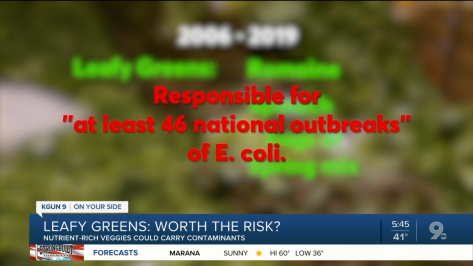
Store Bought Lettuce Food Miles and Nutritional Value
The other factor to consider is how far your lettuce has had to travel to get to your plate. Food miles are the distance food travels from where it is grown to where it is ultimately purchased or consumed by the end user. The term, “food miles” was originally penned from a study in Iowa that focused on how far food had to travel.In 2011, lettuce was grown on 206,000 acres in California (most coming from Salinas, CA), which represented 73% of the total U.S. acreage (Source: Lettuce_Production_CA). If trucks were to drive a straight line (which in reality they don’t — they make pit-stops at processing centers and go to distribution centers before traveling to our local grocery store), lettuce harvested in Salinas, CA must travel a minimum of 3,000 miles to Atlanta, GA and is at least 4-5 days old by the time it reaches our grocery store. It’s estimated that it take an average of 10 days to go from farm to our plate! Are you even getting any nutritional value from eating it at this point? We’ll explore that in a minute…
One thing to note, since the 2019 E Coli outbreaks, the lettuce industry has incorporated a standard of placing labels on packages of romaine to indicate where the lettuce originated from so that the CDC can better track down the source of contamination. (Yes, I’m trying to shake you out of denial — it’s really that bad.)
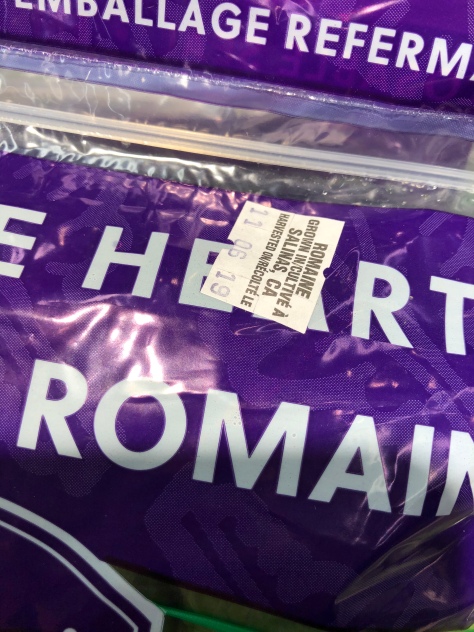
The other factor at play with store-bought lettuce is the depletion of nutrients from the time the lettuce is harvested to the time it reaches our plate. Like mentioned earlier, it takes upwards of 10 days from farm to plate in our traditional food system. Did you know that the nutritional value found in the plant actually starts to deteriorate within the first day or two of harvesting? University of California studies show that vegetables can lose 15 to 55 percent of vitamin C, for instance, within a week. And some spinach, for example, can lose 90 percent within the first 24 hours after harvest!
Here are our tips for growing lettuce with the hydroponic Tower Garden system.
Best Growing Conditions for Lettuce
Of the many varieties of leaf and head lettuce, most prefer full sun and temperatures between 45–80˚, making lettuce a good cool season crop. Lettuce can withstand light frosts. But in hot weather, it will easily bolt (i.e., quickly grow vertically, flower and produce seeds)—and this process typically makes lettuce bitter. So if you grow lettuce in warmer conditions, plant it in partial shade or grow heat-tolerant varieties, like these:

Source: Fix.com
There are five distinct types of lettuce: Loose-Leaf (45-60 days), Cos or Romaine (~70 days), Crisphead (75+ days), French (50-75 days), and Butterhead (55-75 days). With a variety of colors, shapes and flavors available, plant several types of lettuce for tasty and interesting salads. Keep in mind, all varieties of lettuce grow very well indoors with grow lights.
Here is a good starting point of specific seeds to get if you are just starting out:
Click here to view seed recommendations for a hydroponic Tower Garden
How much will I need to grow?
 If you want fresh lettuce every day for salads or other dishes, we suggest growing approximately 2-3 heads of lettuce per person. The cool thing about the Tower Garden system is you can grow in up to 28 ports (base Tower Garden with one extension) in less than a 2.5′ x 2.5′ space. That means in the corner of your kitchen or dining room or on your back deck, you can have instant access to your greens any time and harvest Tower to table within a matter if minutes — not hours — not days — MINUTES! This means you and your family will get optimal nutritional value from each plant because it is being harvested at it’s peak and consumed right away.
If you want fresh lettuce every day for salads or other dishes, we suggest growing approximately 2-3 heads of lettuce per person. The cool thing about the Tower Garden system is you can grow in up to 28 ports (base Tower Garden with one extension) in less than a 2.5′ x 2.5′ space. That means in the corner of your kitchen or dining room or on your back deck, you can have instant access to your greens any time and harvest Tower to table within a matter if minutes — not hours — not days — MINUTES! This means you and your family will get optimal nutritional value from each plant because it is being harvested at it’s peak and consumed right away.
Tower Tip:
To learn when you should grow lettuce in your area, try this planting scheduler.
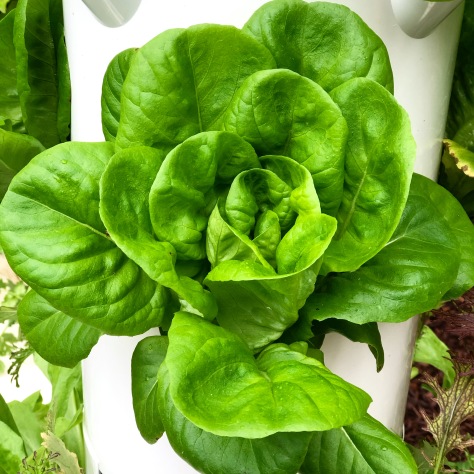
Starting Lettuce Seeds
For leaf lettuces, plant 2–4 seeds per rock wool cube. And for head lettuces, plant only 1 seed per cube. Lettuce seeds need light to germinate and usually germinate within 1–2 weeks.
Keep under bright lights and use a warming pad (we like this one). Can’t stress enough how much a warming pad and a good full-spectrum LED grow light will help your success rate.
Seedlings should be ready to transplant to your Tower Garden 10–14 days after sprouting, or whenever they have at least 2–3 leaves and a visible root structure. When transplanting, keep in mind that lettuce is a good crop to plant near the top of your Tower Garden.

Once you’ve transplanted lettuce into your Tower Garden, keep the pH between 5.6-6.2 as this will help the plant uptake available nutrients in your water promoting growth. Using the Tower Garden Nutrient Solution, keep the PPM range between 560-840 or an EC of 0.8-1.2 for ideal continuous growth. Ten to twelve hours of light will be sufficient. Check the back of your seed packet for maturation as it varies by lettuce type and variety (typically between 30-85 days). Also, some lettuces can be cut and come again meaning if you cut about 2″ from the base of the plant, it will regrow new leaves and thereby extending your harvest.

Download our lettuce cheat sheet that can be sliced down and put into a standard ziplock sandwich bag and used for seed storage and/or as a growing journal for what happened with your crop (we put ours on a clipboard. | download PDF |
Tower Tip: For step-by-step instructions on starting seeds and transplanting seedlings, reference page 7 of the Tower Garden Growing Guide (PDF).
Common Lettuce Pests and Disease
Growing lettuce with Tower Garden decreases the chance of pests and plant diseases. But just in case, here are some potential problems:
- Aphids are small insects that typically feed on young plant growth, causing it to appear puckered or deformed.
- Cabbage loopers are green caterpillars that feed on the underside of lower leaves and in the center of the head of lettuce.
- Cucumber beetles are yellow-orange beetles with black markings that sometimes feed on lettuce seedlings. Take care not to confuse these with ladybugs.
- Botrytis, a gray-brown fuzzy growth, thrives in cool environments and can appear on plant debris that has fallen from the plant.
- Downy mildew looks like fine white cotton or frosting and often infects lower plant leaves first. It can spread rapidly and kill plants in cool conditions.
- Powdery mildew forms a white-gray powdery growth, usually on the upper surfaces of leaves. You’re most likely to see this common disease in late summer.
Tower Tip: Lettuce doesn’t typically suffer with aphids, especially if you’re interplanting basil at the same time (it is a deterrent to aphids.) Learn how you can naturally beat bad bugs and prevent plant diseases.

How to Harvest Lettuce
Since they grow so quickly, lettuces will be ready to harvest within a few weeks after planting. You can harvest lettuce in 2 ways:
Whole head. Remove the entire plant and net pot from your Tower Garden, or cut all the leaves off at the base of the plant. If you choose this method, be sure to have replacement seedlings ready.
Individual leaf. This technique keeps the plant alive and encourages continued production. When there are plenty of mature leaves present:
- Harvest only a few leaves at a time, from the bottom of the plant upward.
- Allow 2–3 leaves to remain so the plant may keep growing.
- Repeat every 2–3 days until the plant bolts, or begins flowering.
- After bolting, replace the plant with a fresh seedling.
You’ll want to eat lettuce within a few days of harvesting. Need ideas for how to use it?
Browse recipes shared by other Tower Gardeners »
More Tips for Growing Lettuce
If you’re hungry for more lettuce growing advice, we have a comprehensive guide available in the Resource Center.
Download lettuce growing guide »
We also have a handy resource that you can print off and cut down and slide into any sandwich-size Ziplock bag and use to store your seeds (limits oxygen and moisture which can be harmful to seed saving. We also print an extra sheet for our garden journal to keep records of how our crop performed so we can learn and remember what worked for the following year.

Happy Growing!
— Erin




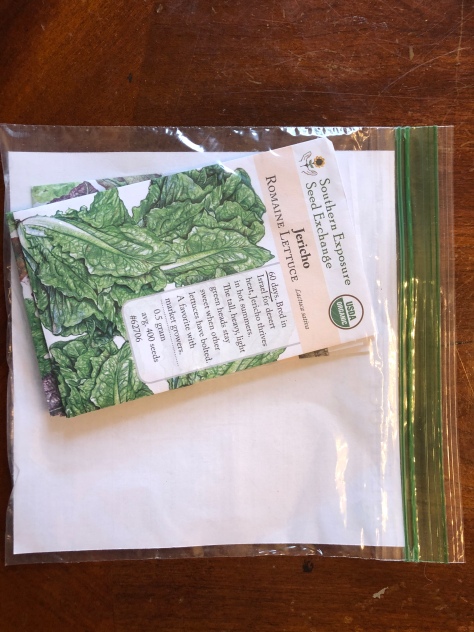
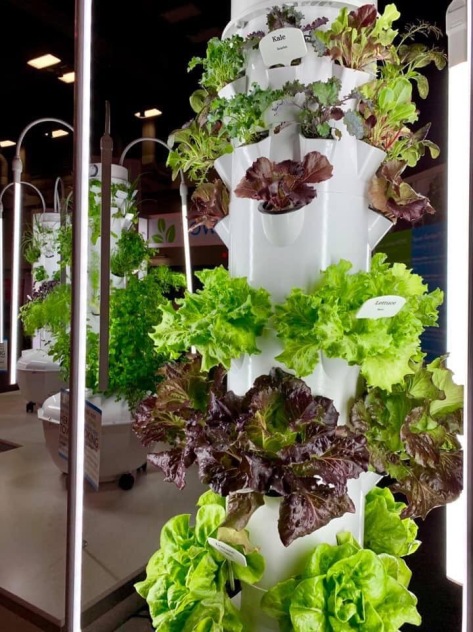


The Tower Garden looks really interesting. I would start with growing the Loose-Leaf lettuce first.
LikeLike